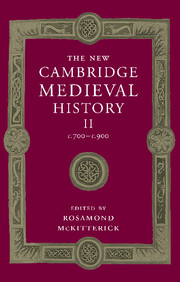Book contents
- Frontmatter
- PART I POLITICAL DEVELOPMENT
- 1 Introduction: sources and interpretation
- 2 The British Isles
- 3 Frankish Gaul to 814
- 4 The Frankish kingdoms, 814–898: the West
- 5 The Frankish Kingdoms, 817–911: the East and Middle Kingdoms
- 6 Fines Imperii: the Marches
- 7 The Vikings in Francia and Anglo-Saxon England to 911
- 8 Scandinavia, c. 700–1066
- 9 Slavs and Bulgars
- 10 The Muslims in Europe
- 11 Spain: the northern kingdoms and the Basques, 711–910
- 12 Lombard and Carolingian Italy
- 13 Byzantine Italy, c. 680–c. 876
- 14 Byzantium and the west, 700–900
- PART II GOVERNMENT AND INSTITUTIONS
- PART III CHURCH AND SOCIETY
- PART IV CULTURE AND INTELLECTUAL DEVELOPMENTS
- Conclusion
- Appendix genealogical tables
- List of primary sources
- Bibliography of secondary works arranged by chapter
- Index of manuscripts
- General index
- Frontispiece">
- Plate section
- Map 4 Charlemagne’s Europe and Byzantium, 814
- Map 19 The ecclesiastical provinces of western Europe 700-900
- Map 20 Carolingian schools, scriptoria and literary centres
- Genealogical table X: Wessex
- References
1 - Introduction: sources and interpretation
from PART I - POLITICAL DEVELOPMENT
Published online by Cambridge University Press: 28 March 2008
- Frontmatter
- PART I POLITICAL DEVELOPMENT
- 1 Introduction: sources and interpretation
- 2 The British Isles
- 3 Frankish Gaul to 814
- 4 The Frankish kingdoms, 814–898: the West
- 5 The Frankish Kingdoms, 817–911: the East and Middle Kingdoms
- 6 Fines Imperii: the Marches
- 7 The Vikings in Francia and Anglo-Saxon England to 911
- 8 Scandinavia, c. 700–1066
- 9 Slavs and Bulgars
- 10 The Muslims in Europe
- 11 Spain: the northern kingdoms and the Basques, 711–910
- 12 Lombard and Carolingian Italy
- 13 Byzantine Italy, c. 680–c. 876
- 14 Byzantium and the west, 700–900
- PART II GOVERNMENT AND INSTITUTIONS
- PART III CHURCH AND SOCIETY
- PART IV CULTURE AND INTELLECTUAL DEVELOPMENTS
- Conclusion
- Appendix genealogical tables
- List of primary sources
- Bibliography of secondary works arranged by chapter
- Index of manuscripts
- General index
- Frontispiece">
- Plate section
- Map 4 Charlemagne’s Europe and Byzantium, 814
- Map 19 The ecclesiastical provinces of western Europe 700-900
- Map 20 Carolingian schools, scriptoria and literary centres
- Genealogical table X: Wessex
- References
Summary
the Frankish dominance of the period covered by this volume poses special problems for the historian, not least because of the apparent concentration of a great diversity of sources from the Frankish heartlands and the relative paucity of material from everywhere else. Indeed, if our understanding of the years between 700 and 900 depended on the historical narratives produced in this period alone, we would be obliged to accept a largely Frankish proclamation of self-confidence and greatness on the part of the ruling elites of Carolingian society, and the Carolingians’ distinctive celebration of the intellectual and cultural vigour of their scholarship and art, as the central points of interest for the eighth and ninth centuries.
Fortunately, however, an enormous range of other categories of evidence, drawn on in all the chapters below – charters, secular and ecclesiastical legislation, law-codes, saints’ Lives, estate surveys, treatises on a wide variety of subjects, liturgical, school and library books, script, letters, tax-lists, poems, relics and relic labels, inventories, penitentials, seals, coins, library catalogues, inscriptions, confraternity books and artefacts of all kinds, ranging from pictures in manuscripts to weapons, jewellery, sculpture and buildings - redress the balance. The archaeological evidence has played a crucial role in adjusting and augmenting our understanding of many developments in this period, most notably in the economic and ecclesiastical spheres, as is clear from the chapters by Blackburn, Verhulst and de Jong.
Keywords
- Type
- Chapter
- Information
- The New Cambridge Medieval History , pp. 1 - 17Publisher: Cambridge University PressPrint publication year: 1995
References
- 1
- Cited by

